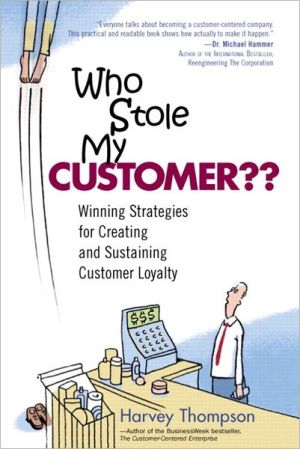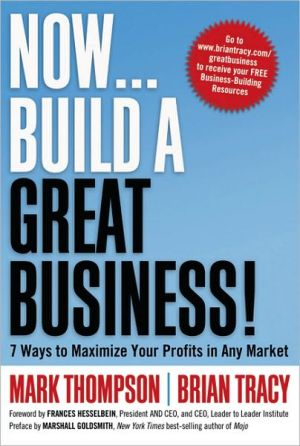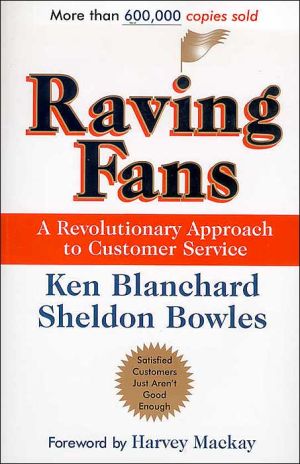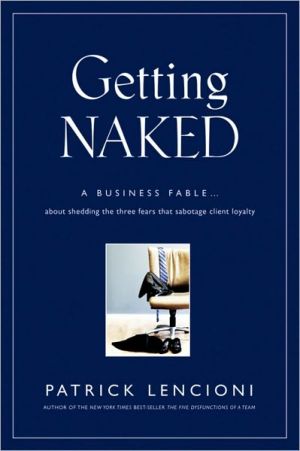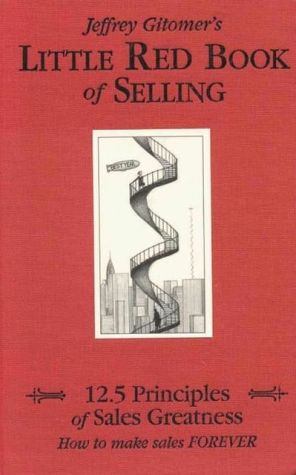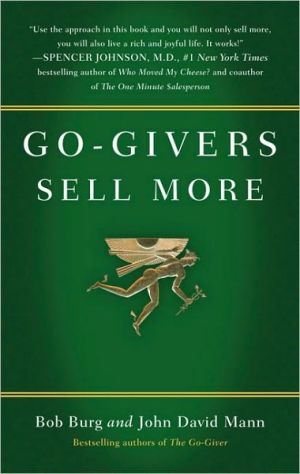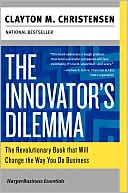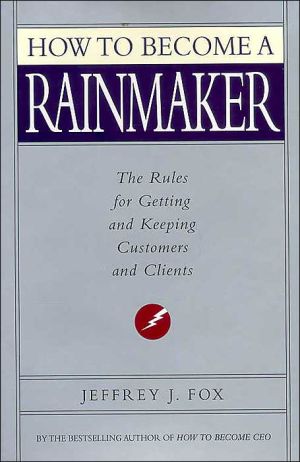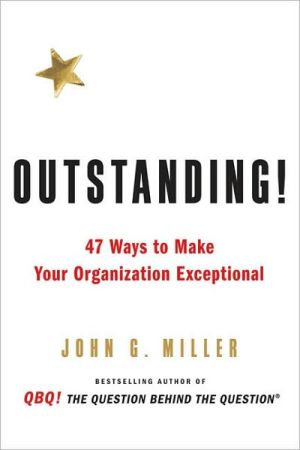Who Stole My Customer? Winning Strategies for Creating and Sustaining Customer Loyalty
Who's stealing your customers? Why is it happening? How can you stop it? These are the toughest questions facing virtually every enterprise. Who Stole My Customer?? is your complete guide to planning and implementing customer loyalty processes that really work-because they're built around what your customers really want.\ Harvey Thompson helps you view your business and its processes through your customer's eyes … and you might be shocked at what you see. You'll systematically discover the...
Search in google:
Who Stole My Customer?? offers unique and powerful insights into the world of acquiring and retaining customers. Most importantly it provides new approaches to keeping existing customers from defection. A must-read in today's challenging business environment.–Dieter Huckenstein, President, Hotel Operations, Hilton Hotels CorporationHarvey Thompson probably knows more about how companies should work with customers than anyone else in the world. In an age when computers and mass communications makes it difficult to keep or attract new customers, Thompson's insights on what managers must do to keep them makes this one of the most important business books published this year. Clearly must reading for all levels of management.–James W. Cortada, IBM Institute for Business ValueHarvey Thompson has done it again with this well-written book that offers valuable insights about the roots of sustained corporate greatness. He captures a lifetime of building winning formulas and puts them into a simple and practical context for executives at any level looking to take their business to the next level in the 21st century.–Mark R. Richards, President, Structures Division, Valmont Industries, Inc.One of the leading causes of the rapid turnover of marketing and sales executives isn't the economy, it's the ignored cancer of customer attrition. Who Stole My Customer?? takes on this challenge head-on and tackles it from a pragmatic perspective with actions you can take today.–Louis Columbus, Senior Analyst, AMR ResearchI think Harvey Thompson really understands how customers feel about products and services-for better or worse! His central point is well taken-take care of them now or lose them to competitors who are more in tune with your customers' needs and wants. This book helps us remember that we must build our offerings from the 'outside in' to build customer loyalty and minimize defection. Thank you, Mr. Thompson!"–Bill Ghormley, Executive Consultant, The Forum Corporation, and Past President, The Marketing Science InstituteA start-to-finish program for addressing your #1 challenge: customer retentionWho's stealing your customers? Why is it happening? How can you stop it? These are the toughest questions facing virtually every enterprise. Who Stole My Customer?? is your complete guide to planning and implementing customer loyalty processes that really work-because they're built around what your customers really want.Harvey Thompson helps you view your business and its processes through your customer's eyes … and you might be shocked at what you see. You'll systematically discover the real drivers of customer loyalty in your business, so you can focus your customer relationship investments for maximum value. Drawing on his unsurpassed experience at IBM and other world-class enterprises, Thompson shows exactly how to rebuild every touchpoint around your customer's needs … and overcome every obstacle that stands in your way. You won't just improve customer retention for a quarter or two: you'll build resilient customer relationships that resist competition for years to come.Current customers are up to nine times as profitable as new ones, but keeping customers has never been tougher. Traditional "customer satisfaction" programs and "Have a Nice Day" platitudes won't cut it anymore. It's time you developed a customer-defined, outside-in vision of your business, plus the capabilities and infrastructure to make it real. Who Stole My Customer?? shows you how to do it. Harvey Thompson led customer-focused process improvement at Lou Gerstner's IBM, helping to drive one of the greatest transformations in business history. Drawing on his experiences with IBM and other world-class enterprises, he'll help you discover how your customers have changed, what they're expecting now, which facets of customer satisfaction actually drive loyalty … and where you're most vulnerable.Next, Thompson shows you exactly what to do about it. You'll learn how to engineer a winning customer experience around your customer's view of the world, and how to "institutionalize" loyalty, making it resilient enough to resist virtually any competitor. A systematic, customer-centered approach to retention. Rebuilding your processes around your customer's real needs and desires. Your customers have changed. Have you? Why your traditional strengths may now be fatal weaknesses. Investing to improve loyalty, not just satisfaction. Which aspects of customer satisfaction drive retention-and which don't. Different drivers for different customers. Segmenting your customers for improved retention. From vision to reality. Implementing world-class customer loyalty capabilities and infrastructure. "Institutionalizing" customer loyalty for the long term. Staying "glued" to your customers-no matter what your competitors do. Soundview Executive Book Summaries In Who Stole My Customer??, the sequel to his bestselling The Customer-Centered Enterprise, Harvey Thompson describes how companies can create and sustain customer loyalty using better strategies for customer retention. Thompson presents the techniques he used while leading customer-focused process improvement at IBM during its transformation under Lou Gerstner, as well as the experiences of several other successful companies. He also introduces many new approaches to keeping customers. Copyright © 2005 Soundview Executive Book Summaries
You are a customer.\ You are considering your next purchase—perhaps to replace an old, well-used product, or possibly to buy a new item or service that you have never before owned.\ Think about it. What will drive your decision regarding where you will conduct this business? What determines whether you do business with one provider of a product versus another? And later, will you return and purchase again from that firm or move on to a new source?\ In today's environment, one firm's products pretty much resemble those of other potential vendors. When a company does introduce a truly unique product idea, their innovation is soon replicated and available from virtually everyone else in their industry. Improvements to existing product lines are also quickly copied by competitors. So, considering the similarities, the product itself is often not the reason that you select one provider over another.\ Consider how you make your buying decisions and how you determine where to conduct your business. Is it strictly based on the product, or do other factors come into play? For example, if you are already a customer and familiar with a firm's products and services, to what extent can the touchpoint experiences you have had (i.e., shop, buy, pay, delivery, and post-sale service) influence whether you will return to purchase there again or defect and buy elsewhere?\ If you learned that a firm, with which you have had no experience, provides great benefit and value during such customer interactions, might you drive across town to purchase from them, although similar products are available nearby? Do you already do that today? Is your favorite source for clothes the nearest haberdashery, or do you travel past nearby stores and shopping areas to get to a preferred retailer? Is your current bank the one most conveniently located to you? Is your car serviced at the closest professional mechanic or gas station, or at the absolutely lowest-cost provider? If not, then why not? Why do you drive past one potential provider to get to another?\ In the past, consumers had to walk or drive to obtain most products and services. Still, they often did not select providers simply on the basis of proximity or a prior relationship. Today, location or a prior business relationship can have even less importance in their selection of a vendor. With overnight or express delivery service, one can literally conduct a global search for the best possible source via the Internet, and often can switch their customer account to a new provider with a mouse-click. So, if you are like most consumers, the customer experiences during touchpoint interactions are increasing as the motivators to remain a customer or to leave. Bad experiences during interactions with a current vendor can easily drive you away, even though you are satisfied with their products, because alternative sources are literally a click away. And extraordinary, positive experiences during touchpoint interactions can give you an incentive to stay with a vendor—or if offered elsewhere, could also attract or steal you away.\ Question: What if such powerful touchpoint interactions were actually designed by you to provide the things you most value during those moments? What if a vendor identified you as a highly desired customer (perhaps based on your financial, psychological, or other characteristics) and let you design their business to provide the greatest possible value to you? What if—even though their products and prices were similar to others—your interactions with them during your shop, buy, pay, receive, and post-sale service interactions were completely designed into their business, outside-in, and from YOUR perspective?\ Can you envision being attracted away from your current bank, automobile dealer, airline, hotel chain, financial services firm, insurance company, retail store, or so on because someone with a relatively equal product knew you, valued you, and did things your way? Can you envision how you could receive value that would differentiate a firm if their sales processes were designed to make your own purchase process fast, easy, and low cost? Could a firm's knowledge of you and your long-running relationship with them enable a more personal, high-value, consultative sales or service relationship that would make them your preferred\ provider?\ For example, if a car dealership, or financial services firm, or audio/video store had a selling process that was literally defined by you to ideally meet your needs, and given that their products were equal or similar to others', would you move your business there? Can you envision how you could later receive extraordinary benefit during interactions with their service processes, if those were also designed from your perspective to make it easy, quick, and ideally convenient for you?\ What if that company's invoicing or billing statements were also designed from your viewpoint, to make it easy to reconcile, pay them, and keep your records, might you prefer doing business with them over others? How about a telephone company bill that you could readily understand, have confidence in, and conveniently pay? If their products were similar, would such a process or service win your business?\ If you are like the hundreds of customers with whom I have met and facilitated in creative, business visioneering exercises, then your answer to each of the above is, "Yes."\ So, if you already know the above to be true when you are a customer, why isn't your business already doing that with your own customers? You are likely both a customer and a provider of goods and services! That's true of most managers, but somehow, when they change hats and assume their provider or vendor roles, managers lose sight of the customer perspective. Instead of designing and measuring business processes and customer touchpoints from their customers' viewpoints (outside-in), managers shed their customer skins, don their management hats and adopt the perspective of the firm (inside-out). Touchpoint interactions and supporting infrastructure are designed from the company's point of view to optimize internal processes, based on an understanding of what may have minimally satisfied customers in the past—possibly back when the firm was more successful. Ironically, when in the role of customers, a firm that allowed them to define and design high-value touchpoint interactions would attract those same managers, however they do not do that with their own customers and are losing them at an accelerating rate. Sound familiar? It should, because it occurs in all industries and is a major obstacle for even the most well-intentioned management teams.\ We will use several techniques in subsequent chapters to overcome this "inside-out" business orientation and help you to more effectively fulfill your role as a business leader. It will not be enough to simply cite to you innovative new ways to become customer centric and retain loyal customers. You have already read business books and articles on such topics, but always with your inside-out filters on. We must overcome the company-first viewpoint that has been ingrained into you from the time you attended your first business course, management seminar, or company meeting. You have been programmed with certain common, business-driven approaches to develop your mission, vision, strategies, plans, and programs. The problem is that those always only include the customer—as opposed to being actually developed, designed, and driven by them. And when you do read a book that promotes how to take more of an outside-in customer viewpoint, you read that material while mentally and emotionally still wearing your company hat. You do not move past mere intellectualization of the material, or viscerally experience the truth of it so it becomes a part of your actual system of beliefs.\ To truly understand and appreciate such customer-centric materials, you must take off your current industry or company management hat and consider the concepts from fresh perspectives. In the effort to contrast a company viewpoint versus a customer viewpoint, the examples used in this book will often be automobile companies or banks because you are a customer of those, and you will be able to visualize and internalize how to improve them from an actual customer's point of view. The customer-centered concepts we will cover are generic and do not apply to only one industry, so once you consider and internalize them via a bank or automotive example, you can later apply them to your own industry and firm.\ For instance: within the examples we will examine the points of view of executives in those firms, so that you can see how they see you as a customer. Then we will place you into the role of the customer, so you can shed your management hat (and the inside-out business viewpoint that accompanies it) as you consider the innovative customer-centric approaches being discussed.\ We begin, in Part 1, with an introduction to an automobile company and the case for action to become more customer centric, attract, and keep your customers.
PrefaceIntroductionPt. 1Customer Defection: The Case for Action1Ch. 1When Prior Strengths Become Your Weaknesses3Ch. 2A Boutique, Alternative Strategy of the 1990s11Ch. 3A Survival Issue and Strategic Imperative of the 2000s19Pt. 2Understanding Loyalty: A Pie Pan of Needs37Ch. 4Product vs. Service Slices39Ch. 5Customer Segmentation and Targeting53Pt. 3Integrating Two Views: Opportunity vs. Risk63Ch. 6Opportunity: The Customer View65Ch. 7Risk: The Company Culture83Pt. 4The Winning Customer Experience95Ch. 8What They Want: Ten Myths About Your Customers97Ch. 9What They Need: Customer Visioneering117Ch. 10What You Must Do: Institutionalize Loyalty157Epilogue: Who Stole My Customer?193Acknowledgments195About the Author199Index201
\ Soundview Executive Book SummariesIn Who Stole My Customer??, the sequel to his bestselling The Customer-Centered Enterprise, Harvey Thompson describes how companies can create and sustain customer loyalty using better strategies for customer retention. Thompson presents the techniques he used while leading customer-focused process improvement at IBM during its transformation under Lou Gerstner, as well as the experiences of several other successful companies. He also introduces many new approaches to keeping customers. Copyright © 2005 Soundview Executive Book Summaries\ \
